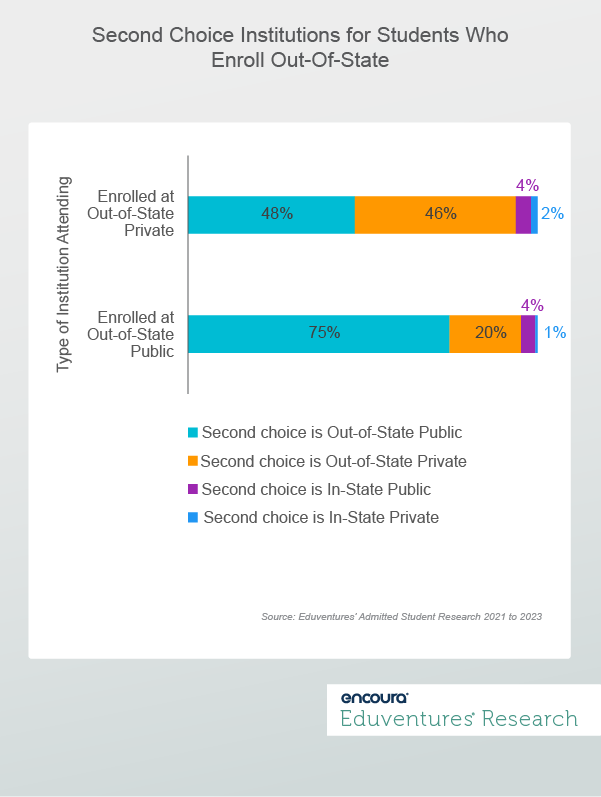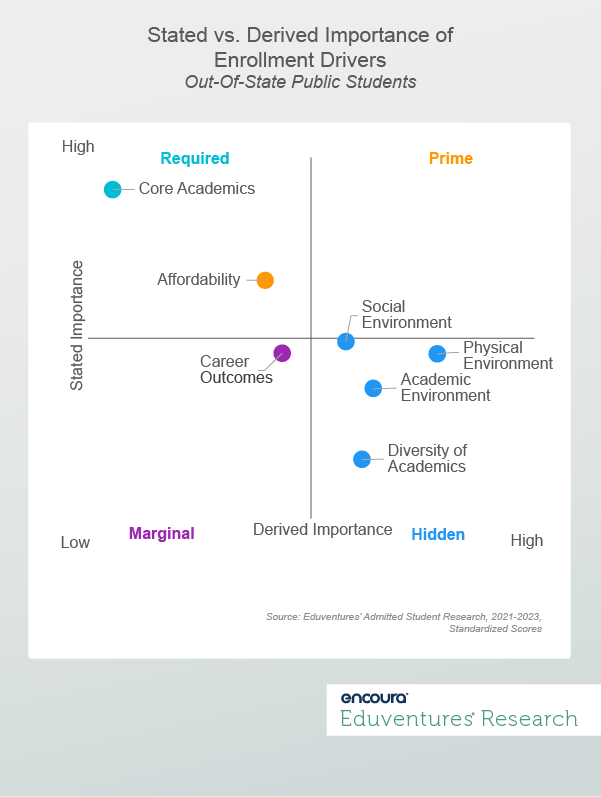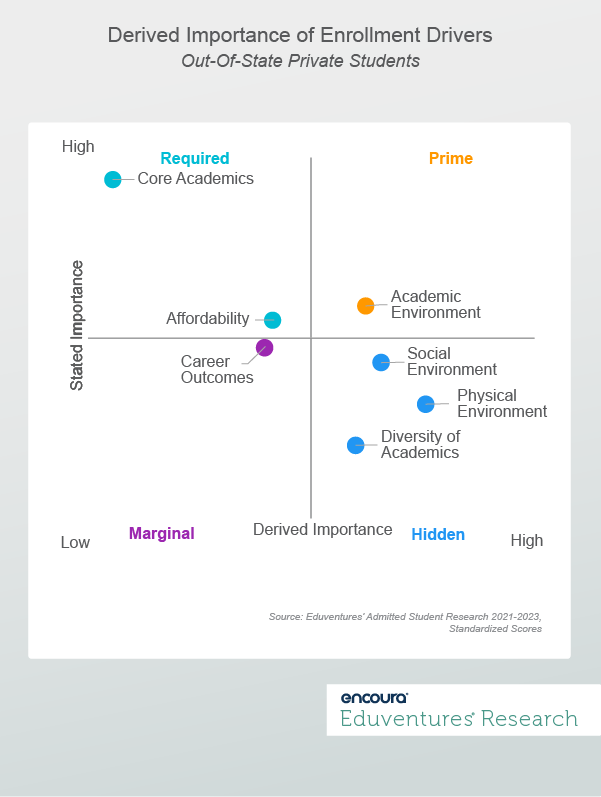The most difficult aspect of yield is differentiating your institution at the finish line, especially among out-of-state students. These students overwhelmingly tell us that the quality of core academics, like the availability of their majors of interest, drives their final enrollment decisions. But our statistical analysis clearly shows that factors like the physical and social environment seem to make a bigger—and perhaps subconscious—impact. So, who is right, the student or the science?
If a student has done their homework and applied to schools that would be a good fit, the final choices often look quite similar on the surface: same majors, costs, and reputations. Helping students understand the nuances of the final decision will tip the decision in favor of your institution.
To do this, the first question we must ask is: what is the decision endgame for the typical out-of-state student? The Eduventures Admitted Student Research™ indicates that the final enrollment decision among these students is often apples-to-apples, at least apples-to-pears, and rarely apples-to-oranges.
Figure 1 shows the second-choice institutions for students who decided to enroll in an out-of-state public or private institution.
Figure 1.
For students who enroll in out-of-state public institutions, the final choice is overwhelmingly apples-to-apples. Three quarters of students who enrolled in an out-of-state public institution had a second choice that was also an out-of-state public institution.
For students who enroll in out-of-state private institutions, the final choice is more apples-to-pears. Almost all students (96%) enrolling in an out-of-state private institution had another out-of-state institution as a second choice. But that competition is nearly evenly split between out-of-state publics (48%) and out-of-state privates (46%).
Students attending out-of-state public institutions said that core academics (64%), affordability (50%), and the social environment (40%) were the top three enrollment drivers influencing their enrollment decisions. Out-of-state private institution students said their top drivers were core academics (69%), academic environment (48%), and affordability (45%).
These, however, are stated importance values—how the students answer our survey questions. In other words, they represent the student’s’ conscious thoughts about their decisions.
But we also know the derived importance of these enrollment drivers on student enrollment decisions. Using regression analysis, we can understand what may unconsciously drive final decisions between the enrollment school and the next best alternative.
Analyzing stated vs. derived importance helps us understand how to differentiate similar institutions to yield out-of-state students. Figure 2 plots both the stated value associated with each enrollment driver (x axis) against the derived value (y axis) of each enrollment driver among students attending out-of-state public institutions.
Figure 2.
Notably, core academics—the top stated enrollment driver for out-of-state public students (top, left quadrant)—was not nearly as important in the derived analysis. In fact, it wasn’t important at all. According to our derived analysis, the physical environment, in close competition with several others, comes out on top (bottom right quadrant). Why is that?
That’s because students’ second choice institutions probably offered very similar core academic experiences and affordability as their enrollment schools. So, these are not differentiators. These are, however, required attributes for your institution. Without core academic quality and, to a lesser extent, affordability, you wouldn’t be in a position to enroll the student at all.
So, what is driving the final decision? No single driver stands out. Social environment and physical environment come the closest, but these are hidden drivers. Students said these drivers weren’t very important, but they turned out to have an outside influence on their decisions. This means that when all else is equal, perceived quality in the social, physical, and academic environments will push students to choose you as an out-of-state destination. The opportunity to differentiate lies in these hidden drivers.
Career outcomes falls into the nebulous area of the marginal driver; it was moderately important in both stated and derived analysis. It’s worth mentioning, but it won’t make much of a difference in the end. It is something the students considered in developing a major interest and finding institutions that could serve that interest. This is a conversation that must happen early in the enrollment funnel.
Applying this analysis to students who choose private institutions yields similar, but not quite the same, results (Figure 3).
Figure 3.
For private out-of-state schools, core academics is still a required price of entry as is affordability (albeit to a much lesser extent). But in the final decision, the academic environment is the prime driver of student decision-making. The social environment and physical environment are the most critical hidden drivers, and career outcomes still occupies that marginal space of modest importance.
Yield strategy for out-of-state private institutions must follow this structure:
- Remind students of the academic strength that drew them to your institution in the first place.
- Confront the challenge of affordability.
- Elevate the narrative on academic environment.
- Build the contextual understanding of your social and physical environments.
- Confirm the development of career outcomes.
The Bottom Line
To yield out-of-state students, you must go beyond the central message of core academic strength that brought you to this point in the decision cycle. If you don’t build depth and differentiation, you won’t win the head-to-head comparison with that institution that looks a lot like yours.




